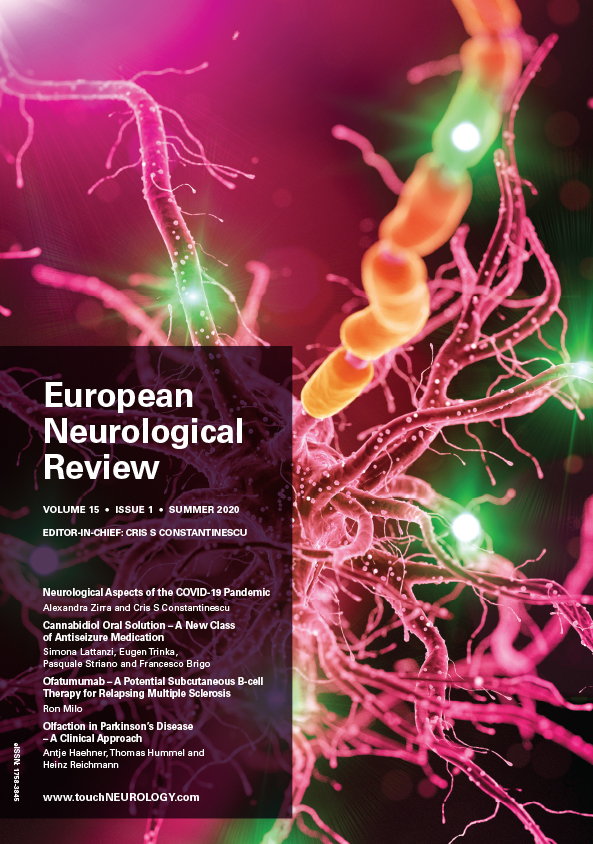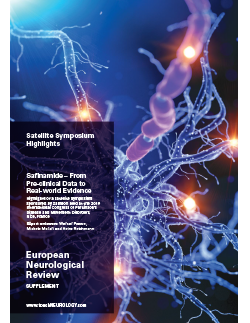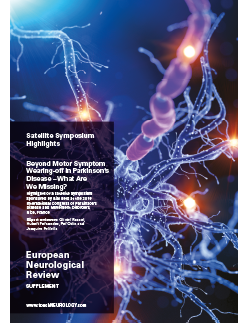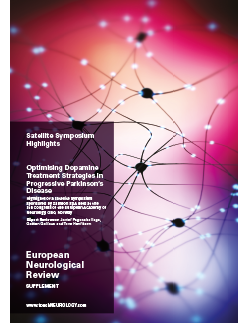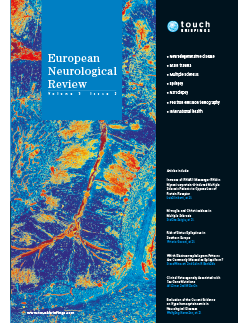
EUROPEAN NEUROLOGICAL REVIEW – VOLUME 3 ISSUE 2 – WINTER 2008
Advisory Panel
In addition to the panel members below, Touch Briefings would like to thank Tamás Dóczi Past Vice President, European Association of Neurosurgical Societies (EANS) Bruno Vellas Principal Investigator, European Alzheimer’s Disease Consortium (EADC) Mary G Baker President, European Federation of Neurological Associations (EFNA)
Foreword
The primary objective of European Neurological Review is to promote the free interchange of neurological and neurosurgical knowledge and experience among its readers. The journal consistently presents clinical research of educational interest, covering multiple sclerosis, brain trauma and stroke, age-related brain degeneration, neurological surgery, neuroradiology and many other important areas. This issue offers useful advice […]
Current Issues
Homocysteine – A Marker for Vitamin Deficiency and a Risk Factor for Neurological Diseases
Age-related Neurodegenerative Disease
The Functions of GSTZ1
Alzheimer’s disease (AD), with its insidious impairment of those most human of faculties – memory, reasoning, judgement and abstraction – exacts a great burden on each individual patient.1 A significant toll is also placed on care-givers – typically the spouse or daughter – as their relative becomes less communicative and more behaviourally disturbed.2,3 This toll […]
Alzheimer’s disease (AD) is a progressive neurodegenerative condition characterised by increasing cognitive, functional and behavioural deficits. Patients with AD suffer continuous progressive memory loss, disorientation, intellectual deterioration, impairment of language skills, declining judgement, agitation and psychosis. Indeed, intellectual deterioration with cognitive dysfunction and behavioural disturbances are major features of disease progression.1 As AD becomes more […]
Alzheimer’s disease (AD) is a multifactorial and heterogeneous disease in both its clinical and histopathological appearance. In more than 99% of cases the cause of the disease is not understood. Independent of its cause, AD is clinically characterised by a developing dementia and histopathologically characterised by neuronal degeneration. Although the presence of neurofibrillary tangles (NFTs) […]
It is now 10 years since the first descriptions of pathogenic mutations within the gene encoding the microtubule-associated protein tau (MAPT).1–3 Over 60 different sequence variants have now been described, including splice-site and missense mutations and deletions, in both coding regions and introns, over 40 of which are thought to be pathogenic.4 Prior to the […]
Parkinson’s disease (PD) is a neurodegenerative disorder that, at least in the early stages, is predominantly characterised by a loss of nigrostriatal dopaminergic function, and the presence of bradykinesia is a sine qua non for diagnosis. As the disease progresses, additional non-motor symptoms sometimes emerge. The natural history of the disorder varies markedly from patient […]
Levodopa is the logical treatment in Parkinson’s disease (PD) as it replaces dopamine that is lost due to the neurodegenerative nature of the disease. It could be considered a natural agonist and remains the most effective dopaminergic replacement therapy. However, in many patients the efficacy of long-term conventional levodopa therapy is hampered by its association […]
UCH-L1 Gene, Protein and Function
Parkinson’s disease (PD) was first described by James Parkinson in 1817 and remains one of the most important disabling illnesses of later life. Although the motor symptoms of the disease are easy to identify, the non-motor symptom (NMS) complex frequently goes unrecognised by healthcare professionals, as reported by Shulman and colleagues.1 This may be because […]
Brain Trauma
More than 700,000 acute strokes1 and 300,000 transient ischaemic attacks (TIAs)2,3 occur annually in the US. It is estimated that between 15 and 26% of acute stroke cases have a prior history of TIA.4 TIAs are important because they are associated with high short-term risk of both stroke and cardiac events. In a widely quoted […]
The Importance of Treating Stroke
Intravenous (IV) thrombolysis with recombinant tissue plasminogen activator (rt-PA) is one of the most effective stroke therapies yet established. However, current clinical guidelines recommend this therapy only within three hours of the onset of ischaemic stroke symptoms, although, according to a pooled analysis of computed tomography (CT)- based IV thrombolysis stroke trials, the beneficial effect […]
The Cerebral Stroke Center at Wakakusa Daiichi Hospital in Japan used computed tomography perfusion (CTP) for selecting candidates for catheter thrombolysis therapy from June 2002 to June 2005, until the treatment guidelines, which were for thrombolysis therapy by intravenous administration of recombinant tissue-type plasminogen activator (alteplase) for hyper-acute cerebral stroke patients, were established by the […]
Aphasia is an acquired language disorder affecting more than 20% of stroke patients.1–3 Six months post-stroke, 12% of survivors still suffer significantly from this severely incapacitating deficit,1 the prognosis depending mainly on the extent and localisation of the infarction. A Cochrane review could not determine whether speech and language therapy is more effective than informal […]
It is more than half a century since Lars Leksell developed stereotactic radiosurgery and the ability to deliver protons to discrete areas of the brain to irradiate tumours. However, while there have been many improvements made to the nature and method of radiation delivery, the stereotactic head frame used to co-ordinate the beams and keep […]
Multiple Sclerosis
Multiple sclerosis (MS) is a complex neurological disease with a far-reaching impact on patients and families throughout a lifetime with the disease. Its hallmark is uncertainty; it has physical, emotional, financial and psychosocial implications throughout its course. Care in MS has evolved from a wait-and-see attitude during the mid-1900s to a more proactive stance with […]
It has been 15 years since the first disease-modifying therapy (DMT) for multiple sclerosis (MS) was licensed, and 14 years since it became available in Europe. The intervening time has seen the introduction of other DMTs and clarification of the indications for their use.1 Physicians who treat MS patients can choose between four available interferons […]
Management and Care – The Changing Landscape of Multiple Sclerosis
Type I Interferons and Their Receptor
Initial biochemical investigations led to the unexpected discovery that plasma samples of patients with Gaucher disease (GD), a lysosomal storage disease, had a several hundred-fold elevated ability to hydrolyse chitin, a polymer of beta 1,4-linked N-acetylglucosamine that is largely diffuse in nature.1 Later, the same investigators observed that lipid-laden activated macrophages accumulating in GD tissues […]
Multiple sclerosis (MS), a chronic inflammatory disorder of the central nervous system (CNS), is the most common neurological disease among young adults, and carries the potential risk of permanent disability. The pathological hallmarks of the disease are multifocal white (and, most recently, also grey) matter lesions, which are characterised by variable extents of inflammation, demyelination, […]
Epilepsy
The inability to adequately treat all patients with refractory epilepsy provides a continuous impetus to investigate novel forms of treatment. Neurostimulation is an emerging treatment for neurological diseases. Electrical pulses are administered directly to, or in the surrounding area of, nervous tissue in order to manipulate a pathological substrate and to achieve a symptomatic or […]
The accurate diagnosis of epilepsy is difficult. Studies in tertiary epilepsy centers have shown that 30% of adult patients referred for intractable ‘epilepsy’ have non-epileptic events, chiefly psychogenic non-epileptic spells (PNES).1 Likewise, in pediatric epilepsy centers, 15–39% have non-epileptic paroxysmal events.2,3 The electroencephalogram (EEG) can be both helpful and misleading in diagnosis. In children, up […]
Narcolepsy
Narcolepsy with cataplexy affects approximately one in 2,000–3,000 people in most societies,1 but about 80% of individuals are thought to remain undiagnosed despite recent refinements to diagnostic criteria.2 The negative social impact of narcolepsy with cataplexy has been extensively studied, and includes impairment in driving skill, high prevalence of car, machine or domestic accidents and […]
Positron Emission Tomography
Positron emission tomography (PET) utilises biologically active molecules in micromolar or nanomolar concentrations that have been labelled with short-lived positron-emitting isotopes. The physical characteristics of the isotopes and the molecular specificity of labelled molecules, combined with the high detection efficacy of modern PET scanners, provide sensitivity for in vivo measurement that is several orders of […]
International Health
The epidemiological features of status epilepticus (SE) are in the course of definition.1 In northern and central Europe, an incidence of 10.3 and 17.1/100,000/year and a mortality rate of 7.6 and 9.3% have been reported, respectively.2,3 In southern Europe, an incidence of 10.7 and 11.6/100,000/year and a mortality rate of 7 and 39% have been […]
Motor neuron disorders (MNDs) are a group of neurological disorders in which motor neurons are destroyed. Motor neurons are large cells that control voluntary muscle activity, including speaking, walking, breathing, swallowing and general movement of the body. MNDs are generally progressive, but there are exceptions. In upper MNDs, cells in the motor cortex of the […]

Trending Topic
Chronic inflammatory demyelinating polyradiculoneuropathy (CIDP) is a rare, autoimmune neurological disorder in which peripheral nerve demyelination typically results in weakness, impaired limb sensation, fatigue and pain.1–4 CIDP may adversely affect activities of daily living, with a substantial impact on functional ability and psychological well-being.2–6 Primary treatment goals are reducing symptoms, improving functional status and maintaining long-term remission.7 The […]
Journal Archive
European Neurological Review is a peer-reviewed, free-to-access, bi-annual neurology journal comprising review articles, case reports, practice guides, theoretical discussions, and original research. It features balanced and comprehensive articles written by leading authorities, addressing the most important and salient developments in the field of neurology in practical terms.
Latest articles videos and clinical updates - straight to your inbox
Log into your Touch Account
Earn and track your CME credits on the go, save articles for later, and follow the latest congress coverage.
Register now for FREE Access
Register for free to hear about the latest expert-led education, peer-reviewed articles, conference highlights, and innovative CME activities.
Sign up with an Email
Or use a Social Account.
This Functionality is for
Members Only
Explore the latest in medical education and stay current in your field. Create a free account to track your learning.


